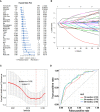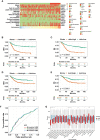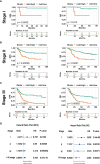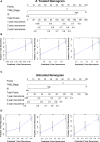An Immune Cell Signature Is Associated With Disease-Free Survival and Adjuvant Chemosensitivity of Patients With Resectable Gastric Cancer
- PMID: 33613554
- PMCID: PMC7890018
- DOI: 10.3389/fimmu.2020.621623
An Immune Cell Signature Is Associated With Disease-Free Survival and Adjuvant Chemosensitivity of Patients With Resectable Gastric Cancer
Abstract
Increasing evidence has indicated that current tumor-node-metastasis (TNM) stage alone cannot predict prognosis and adjuvant chemotherapy benefits accurately for stages II and III gastric cancer (GC) patients after surgery. In order to improve the predictive ability of survival and adjuvant chemotherapy benefits of GC patients after surgery, this study aimed to establish an immune signature based on the composition of infiltrating immune cells. Twenty-eight types of immune cell fractions were evaluated based on the expression profiles of GC patients from the Gene Expression Omnibus (GEO) database using single-sample gene set enrichment analysis (ssGSEA). The immunoscore (IS) was constructed using a least absolute shrinkage and selection operator (LASSO) Cox regression model. Through the LASSO model, an IS classifier consisting of eight immune cells was constructed. Significant difference was found between high-IS and low-IS groups in the training cohort in disease-free survival (DFS, P < 0.0001) and overall survival (OS, P < 0.0001). Multivariate analysis showed that the IS classifier was an independent prognostic indicator. Moreover, a combination of IS and TNM stage exhibited better prognostic value than TNM stage alone. Further analysis demonstrated that low-IS patients who had more tumor-infiltrating lymphocytes had better response to adjuvant chemotherapy. More importantly, we found that patients with high-IS were more likely to benefit from a Xeloda plus cisplatin regimen after surgery. Finally, we established two nomograms to screen the stage II and III GC patients who benefitted from adjuvant chemotherapy after surgery. The combination of IS classifier and TNM stage could predict DFS and OS of GC patients. The IS model has been proven as a promising tool that can be used to identify the patients with stages II and III GC who may benefit from adjuvant chemotherapy.
Keywords: DFS; XP; adjuvant chemotherapy; gastric cancer; immunoscore.
Copyright © 2021 Yan, Chen, Yang, Li, Che, Xiao, Liu and Qu.
Conflict of interest statement
The authors declare that the research was conducted in the absence of any commercial or financial relationships that could be construed as a potential conflict of interest.
Figures







Similar articles
-
Association of Tumor-Associated Collagen Signature With Prognosis and Adjuvant Chemotherapy Benefits in Patients With Gastric Cancer.JAMA Netw Open. 2021 Nov 1;4(11):e2136388. doi: 10.1001/jamanetworkopen.2021.36388. JAMA Netw Open. 2021. PMID: 34846524 Free PMC article.
-
ImmunoScore Signature: A Prognostic and Predictive Tool in Gastric Cancer.Ann Surg. 2018 Mar;267(3):504-513. doi: 10.1097/SLA.0000000000002116. Ann Surg. 2018. PMID: 28002059
-
Immunomarker Support Vector Machine Classifier for Prediction of Gastric Cancer Survival and Adjuvant Chemotherapeutic Benefit.Clin Cancer Res. 2018 Nov 15;24(22):5574-5584. doi: 10.1158/1078-0432.CCR-18-0848. Epub 2018 Jul 24. Clin Cancer Res. 2018. PMID: 30042208
-
Tumor Immune Microenvironment and Chemosensitivity Signature for Predicting Response to Chemotherapy in Gastric Cancer.Cancer Immunol Res. 2019 Dec;7(12):2065-2073. doi: 10.1158/2326-6066.CIR-19-0311. Epub 2019 Oct 15. Cancer Immunol Res. 2019. PMID: 31615816
-
Predictive test for chemotherapy response in resectable gastric cancer: a multi-cohort, retrospective analysis.Lancet Oncol. 2018 May;19(5):629-638. doi: 10.1016/S1470-2045(18)30108-6. Epub 2018 Mar 19. Lancet Oncol. 2018. PMID: 29567071
Cited by
-
Immunoscore Combining CD8, FoxP3, and CD68-Positive Cells Density and Distribution Predicts the Prognosis of Head and Neck Cancer Patients.Cells. 2022 Jun 28;11(13):2050. doi: 10.3390/cells11132050. Cells. 2022. PMID: 35805132 Free PMC article.
-
SMOX expression predicts the prognosis of non-small cell lung cancer.Ann Transl Med. 2021 Jul;9(13):1048. doi: 10.21037/atm-21-998. Ann Transl Med. 2021. PMID: 34422960 Free PMC article.
-
N6-methylation in the development, diagnosis, and treatment of gastric cancer.J Transl Int Med. 2024 Mar 21;12(1):5-21. doi: 10.2478/jtim-2023-0103. eCollection 2024 Feb. J Transl Int Med. 2024. PMID: 38525439 Free PMC article.
-
Landscape of B lymphocytes and plasma cells in digestive tract carcinomas.Ann Gastroenterol. 2025 Jan-Feb;38(1):1-11. doi: 10.20524/aog.2024.0936. Epub 2024 Dec 12. Ann Gastroenterol. 2025. PMID: 39802286 Free PMC article. Review.
-
Dissecting the Role of Immune Checkpoint Regulation Patterns in Tumor Microenvironment and Prognosis of Gastric Cancer.Front Genet. 2022 Apr 19;13:853648. doi: 10.3389/fgene.2022.853648. eCollection 2022. Front Genet. 2022. PMID: 35518357 Free PMC article.
References
-
- Lee J, Lim DH, Kim S, Park SH, Park JO, Park YS, et al. Phase III trial comparing capecitabine plus cisplatin versus capecitabine plus cisplatin with concurrent capecitabine radiotherapy in completely resected gastric cancer with D2 lymph node dissection: the ARTIST trial. J Clin Oncol Off J Am Soc Clin Oncol (2012) 30(3):268–73. 10.1200/JCO.2011.39.1953 - DOI - PubMed
-
- Kim S, Lim DH, Lee J, Kang WK, MacDonald JS, Park CH, et al. An observational study suggesting clinical benefit for adjuvant postoperative chemoradiation in a population of over 500 cases after gastric resection with D2 nodal dissection for adenocarcinoma of the stomach. Int J Radiat Oncol Biol Physics (2005) 63(5):1279–85. 10.1016/j.ijrobp.2005.05.005 - DOI - PubMed
Publication types
MeSH terms
Substances
LinkOut - more resources
Full Text Sources
Other Literature Sources
Medical
Miscellaneous

